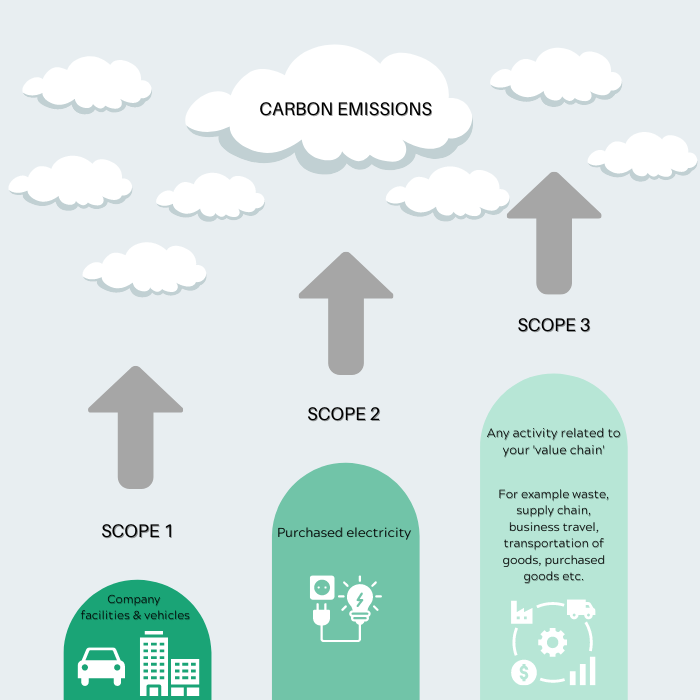
Many businesses are unsure on how to begin their journey toward a sustainable future. An effective way to start is by measuring and reducing carbon emissions.
Let's start off with the basics, what are carbon emissions? Carbon emissions is an umbrella term that refers to the variety of harmful gases (greenhouse gases) that are released into the earth’s atmosphere as a result of human activities.
Greenhouse gases include carbon dioxide (CO2), methane, nitrous oxide, F-gas and water vapour, but are referred to collectively as ‘carbon emissions’ to standardise measurement in terms of their impact on global warming.
CO2 is by far the most common of the greenhouse gases, accounting for around 76% of all emissions. Hence, it provides the yardstick by which we can measure the impact of other greenhouse gages. As an example, releasing 1 kg of methane into the atmosphere is about equivalent to releasing 84 kg of carbon dioxide.
Every business engages in activities that release carbon emissions into the atmosphere, which in turn contributes to climate change. It could be methane emitted by cows, consuming electricity produced using fossil fuels or carbon released during industrial processes like cement making.
This list is not exhaustive, but let’s be clear all businesses have activities that release carbon emissions into the atmosphere which contribute to climate change, no matter how small.
Recognising the importance of measuring and reducing carbon emissions is one thing. Understanding how to do it is another matter. The terminology can feel overwhelming and technical details hard to understand. However, we want to eliminate that feeling and explain how you can get started.
Doing this will benefit your organisation as well as the environment. It means you can:
- Identify which areas of your organisation emits most carbon
- Demonstrate to your customers, staff and stakeholders that you are taking climate action
- Identify quick ways to reduce emissions; often these can save money by reducing energy use
- Help ensure your license to operate complies with existing regulations on climate change
- Attract business and new customers looking for socially conscious organisations
- Increase your brand value as you become more socially and environmentally aware.
In addition to these benefits, businesses will soon be compelled to take action to cut carbon emissions with legislation coming down the track as the UK pushes to meet its net zero target by 2050.
Businesses can reduce their carbon emissions by breaking down their emissions into three categories; Scope 1 (direct emissions from your own business activities), Scope 2 (emissions from the energy you purchase), Scope 3 (indirect emissions associated with your supply chain, value chain and end user).
Starting off - Scope 1 & 2Scope 1 emissions relate to emissions that are released as a direct result of activities undertaken by an organisation. This refers to emissions particularly associated with company vehicles and company facilities e.g., fuel combustion in boilers, furnaces, petrol, diesel etc.
Scope 2 emissions are referred to as being indirect. These emissions relate to purchased electricity, heating, and cooling.
Scope 1 and 2 are relatively easy for an organisation to measure, as these emissions can be measured by energy bills, fuel cards etc. The measurement of Scope 3 emissions is where it begins to get a little bit more challenging.
Scope 3
Scope 3, in the same sense as Scope 2, relates to indirect emissions that are as a result of the organisation. However, Scope 3 emissions refer to the ‘value chain’ (basically your supply chain). This includes suppliers, production of purchased products, transportation of purchased products, or use of sold products. The Carbon Trust have broken down Scope 3 into the following:
- Purchased goods and services
- Business travel (in a vehicle not owned by the business)
- Employee commuting
- Waste disposal
- Use of sold products
- Transportation and distribution (up- and downstream)
- Investments
- Leased assets and franchises
Why is measuring your carbon emissions important?
Measuring your businesses carbon emissions gives you an understanding of your carbon footprint. Without this understanding, it is a little bit like shooting in the dark when it comes to taking effective climate action. Knowing where your largest carbon emissions arise will help you to make decisions on where best to take climate action and helps businesses to create a measurable action plan. This could be based on pay-back-period, customer requirements and most significant impact
The way in which you address sustainability and efficiency of your business, will not only impact you, your business, or your customers, but the climate crisis of the planet.
Our partner Bristol Green Capital Partnership has a guide for SME’s which gives useful advice on how to measure your carbon emissions with the scope framework.
Once you have measured your emissions you can set targets on how to make improvements. Some organisations have made their targets and actions of their scope emissions public. This is a great way to highlight not only how your organisation is acting against climate change, but it also encourages other businesses to become involved in this as well.
- Log in to post comments
